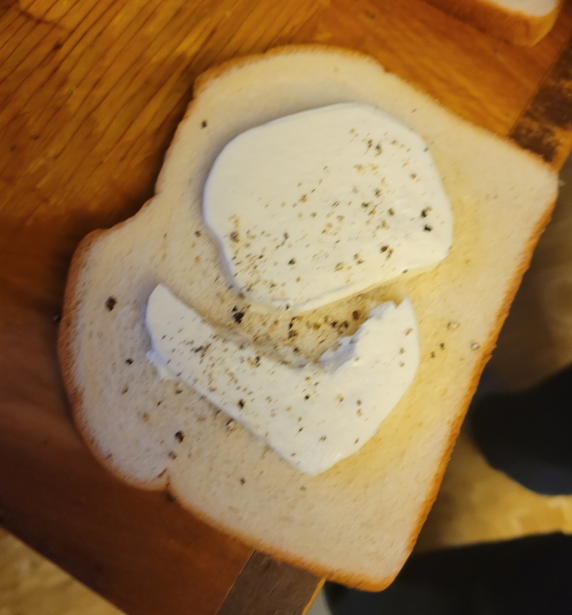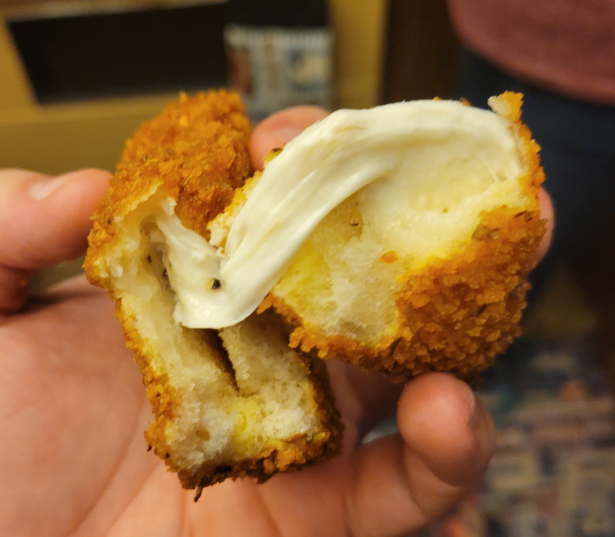KC 313 – Mozzarella in Carrozza

Why hello there, and welcome back to Kitchen Catastrophe, where I wish I could tell you we made a lot of progress by skipping last Thursday’s post, but materially, I’ve just ended up with a lot of shelving and alcohol. I’m your Beer-Beset Builder of Board-Game Borganizers, Jon O’Guin, and in the spirit of being both over and under-whelmed, today’s recipe is surprisingly simple, and simply surprising. I learned all my descriptive skills from The Blue Falcon. No, that’s the Hanna Barbera one. Um…The Sphinx? Is that his name? It’s been a while since I saw Mystery Men. (It is.) Great. So you can jump down to the recipe if you want to skip whatever this whole vibe is. For everyone else, let’s dig in.
A Little Bit of Shelf Reflection
Look, I’m not going to lie to you. I’m a little loopy right now, and this recipe is both kind of simple, and there’s not a lot to be said about it. Mozzarella in Carrozza is the Italian version of a grilled cheese sandwich. That’s it. The name means “mozzarella in a carriage”, with most people believing the name is a reference to the cheese-pull of the molten mozzarella looking like the reins of a fancy carriage, or, for a lesser purported meaning, it refers to the browned (often cut into squares) bread as a “carriage” for the cheese.
Hell of a cheese pull there, amigo.
Boom. You understand the dish. Or, well, you have the basics. We’ll get into why it’s different in a bit. For NOW, I wanna…go to sleep. BYE.
Oh. How nice of you, Sunday Night Jon. A real team effort. You wrote less than a FIFTH of a post, spoiled the crux of the dish, and then passed out after rambling about 23 year old movies with surprisingly robust casts. Did you know Corbin Bleu, of High School Musical, was in Mystery Men? CeeLo Green? Geoffrey Rush? Michael Bay has a cameo as an evil frat boy.
Also at this meeting? Big Tobacco.
In past Jon’s defense, the energy of this past week has been very weird. Nate is out of town, and for some reason, my mother immediately decided she wanted to re-organize the house. I have, in the last eight days, unloaded a thing of shelves of board games, so I could move them onto a bigger set of shelves, so I could move the first unit out of its spot to move in a third unit to make space for the second, and THEN took the first unit upstairs, loaded it, decided it wasn’t big enough, built a FOURTH unit in its spot, and loaded that. And that’s only MOST of the work with shelves done this week.
Sure, the progress LOOKS nice, but at what cost?
I also took my car to the mechanic, emptied a fridge of expired alcohol, and then bought more than enough alcohol to restock said fridge.
The ONLY thing keeping this from really overwhelming me is, as I might have mentioned a couple posts ago, and have definitely discussed with a couple people, including my therapist, is that I hit an emotional breaking point, said “fuck it”, and planned and cooked around 10 recipes in 7 days. And while it’s certainly given me a stockpile of content to fall-back on, the difficulty of that choice is that it wasn’t intelligently assembled. (You know, because of the “emotional breaking point” thing.) One of the oft-overlooked elements of running a blog like this is the emotional and intellectual labor of managing post order: you want posts to feel semi-relevant, or connected to broader trends or details. The Irish Hand Pies to hit both Pi Day and St Paddy’s Day are a great example, and using them/St Paddy’s Day to discuss a new piece of Irish food history I’d learned is a great example of how I like to connect Monday and Thursday posts.
But part of the problem is that, as a writer and content organizer, I can fall into something of a paradox of choice: I have so many options available, or so many options require other commitments, that it can be emotionally distressing to have to sort through them all. You’ve got 20 different variables, and you’re trying to condense them. Let me give you a real set of examples:
So, of the 10 recipes I churned out in that week, 6 came from the same cookbook. Two I’ve already posted. So maybe I want to do a whole month of Monday content from just that book. That sorts out a bunch of Monday posts, but then how to I connect them to Thursdays? One is a spicy chicken cutlet recipe, so…here, here’s a product of spicy chicken that I have a personal connection with, that would make a good Thursday post, but I’d need to eat it WITH someone, so it’ll have to wait until I go to Leavenworth. Also, if I’m making a month of posts from Molly’s cookbook, obviously the “Month of Molly” should be May, right? That’s just intuitive. But then…what do I do for Cinco de Mayo? None of the recipes I made are Mexican. Oh, but her WEBSITE has one that at least uses a regional Mexican salsa. So I can just sign up for her website, cook an additional recipe, and boom, problem solved. Great…but now I’m assigning all those recipes to May, meaning I still have to get through March and April. So now I need another 2-3 recipes for April. And what are THOSE going to be/be connected to?
Turtle pizza?
So I’m juggling a fair number of mental plates in addition to these shelves. Which is why this is actually a great recipe to cover, because it’s surprisingly simple.
Get in the Carriage, Bitch, We’re Going Frying
So, the primary difference between Mozzarella in Carrozza and an American Grilled Cheese is that the MiC is fried. And I don’t mean like how the American is technically fried because you cook it in a pan with oil. (Yes, American Grilled Cheese sandwiches aren’t actually grilled, I will probably talk about that on Thursday, though it might be a little thin.) No, I mean “fill your pan ½” deep” or “2 inches deep” kind of fried. We cooked ours at full deep-fry.
And you may have noted those were two rather distinctly different measurements. Well, an interesting thing about this dish is that it has a LOT of minor variations. At its core, there are 3 required elements: Mozzarella, Bread, and oil to fry. Depending on where you get it or who makes it, however, will change a lot. Some recipes really make it almost exactly like a grilled cheese, just shallow-frying the bread instead of ‘dry frying’. Some found that, depending on the bread or oil, the result was too soft, so they slap some dried bread-crumbs on the bread. Some, like today’s recipe, go even further, dredging the sandwich so the bread is coated in breadcrumbs, and still others make a full batter, and dip the sandwich into a wet batter before frying. Which is where the other major component/cultural touchstone for this recipe comes in. Because at the end of the day, this is a dish that consists of a molten center of mozzarella encased in a fried bread coating. AKA “A Mozzarella stick”.
Or a wide variety of other options, if you’re from a Hispanic country.
Interestingly, as far as I can tell, the two have very little to do with each other, other than the basic building blocks. Like, Mozzarella sticks have a complicated and contested history, because surprise, I DO actually have stuff to talk about! I just figured it was only worth a couple hundred to 1,000 words, and needed to kill an extra 600 or so whining about shelves.
Stick It To the Man
So, first things first: the idea of something LIKE mozzarella sticks is not particularly new: there is a 630 year old recipe in, of all things, a FRENCH cookbook, or well, technically, the recipe section of a French book teaching women how to be good housewives: like, it had advice on how to get laid, how to manage household finances, gardening tips, poetry, how to be fun and likeable, and some recipes.
How to dress like Professor Quirrell, for instance.
The book proposes a batter of egg yolk, flour, salt, and wine, in which slices of cheese are rolled and then fried. Which makes sense that it was invented fairly early on: people figured out pretty quick that, if you can afford it, melted cheese is pretty rad, and a crunchy shell to hold it in is nice. But it was always kind of a niche idea: it’s not a dish that KEEPS super well, it needs to be served pretty quickly, and cheese has always been fairly expensive, so it was just kind of a minor niche idea for fancy dinner parties.
Mozzarella itself doesn’t show up until around 130 years AFTER that recipe…maybe. That’s the first time anyone write down ‘mozzarella”, but two things are important about that: see, Mozzarella is one of those irritating words that’s just a modified version of another word. Like “gordito” means “little fatty”, (Gordo is Spanish for “fat”), Mozzarella is the diminutive form of a Southern Italian dialect word, either mozza (cut) or mozzare (to cut off).The name basically translates into English as, depending on how you read it something like “tiny cuts” or “that which is cut small” (“itty bitty pieces” if you like), referring to the fact that you cut up mozzarella cheese finely before stirring it together and pulling it to form the stretchy bricks we know and love. The problems with that is about 400 years before someone writes down “mozzarella”, someone writes that an abbey in Southern Italy offers traveling pilgrims bread “with mozza”, which, again, just means “cuts”, but is also one of the root words for the cheese’s name. So was it “cuts” (of whatever we had available), or was the cheese originally named “mozza”, and this is the first reference to it? We don’t know, and unless we find some new 900 year old books or notes lying around, probably will never know.
Anyway, while a decently popular cheese, it’s not until the rise of pizza that mozzarella production really takes off, especially in international markets. It’s not until the 1960’s and 70’s, when post-war Italy is producing tons and tons of the stuff, because pizza is really starting to be a hit in America, and frying technology hits a point of mass marketability, so bars, bowling alleys, and other places where you want food that’s quick cooking, hot and salty to convince customers to buy more beer can afford to start getting deep fryers, that the modern mozzarella stick just kind of…appeared, one day.
The 60’s were a great time for “crispy-brown mysterious wanderers”.
No one’s 100% sure who invented the modern day version, because…why would you care? At the time, it was probably “invented” by some corporation who invented a machine to industrialize production of fish sticks, and they were trying to figure out other markets to pitch the machine into: “alright, we’ve got a machine that cuts fish into little rectangles, breads them, and freezes them. What else do we put through this?” “What about bricks of cheese?” “Johnson, you’re a genius.”
Meanwhile, in Italy, the mozzarella in carrozza has just been quietly trucking along for a couple centuries The pathway there is simpler: MiC (the full name is way too many z’s to be tossing around willy-nilly) was an appetizer and street food: you’d get a shallow pan of oil, slap some bread in it, melt the cheese, and serve the sandwich to a customer. Depending on where you were, there might be a little meat or sauce in with the cheese, and different breads would be used. Just toss the guy a couple…I think Lira? Lira used to be the currency of Italy, right? I think that’s a crossword answer.
I assure you, I would know. I PAY for this shit.
Anyway, a bit of cash, a hot sandwich, and you’re on your way. So how’d we fuck it up?
Splish Splash I was Frying some…Cash?
Forgive Title Jon, he’s…not well. Anywhoodles, Like I said, this is a very basic enterprise, when all is said and done. Get yourself some sliced mozzarella (or buy mozzarella and slice it yourself, like some kind of peasant) and put it on bread.
Maybe put more of them than this. We’ll talk about this.
Hit it with some salt and pepper, slap a second slice of bread on top, and cut off the crusts. I don’t 100% know why you do that for this recipe. Like, I’ve found plenty of recipes where the crusts stay on, and some where you cut the crust off so you can pinch the bread together (forming like, a Mozzarella uncrustable), but this one just has you cut them off and then treat the bread like normal. Maybe with the deep frying, the crust gets overcooked, and gets a little burnt, I don’t know. Also, I want to note that Saveur magazine LIES to you with the recipe, as the recipe as written has you cut all the sandwiches in half diagonally, before breading and frying them, while the dish as pictured is clearly fried whole, and THEN cut in half HORIZONTALLY. I understand it’s maybe more visually interesting, but you could just cut the fried halves into quarters for the same effect and no deception. That kind of trickery makes my oil-clogged blood boil.
Speaking of, you’ve been heating oil in a pan, pot, or wok, right? I’ve recently really come around to deep frying in a wok: the angled design means you can save some oil if you’re only going like, 2-3 inches deep, and the continuing sides of the wok help catch spattering oil, keeping your stove top from adopting a fine sheen of grease. So get the oil heating as you prepare the standard dredge station line up: Flour, egg, breadcrumbs. Flop your sandwiches in the flour, then the egg, then the breadcrumbs.
These are actually panko breadcrumbs, because we were out of “normal”, but like we said, the breadcrumbs are, by old-school rules, optional, so feel free to riff.
Then toss them in the hot oil for around 1 minute per side. We adopted a chain process, where we started with one sandwich in the oil, and then, when we flipped it, we added a second. Then, when we flipped the second one, we removed the now-fully-cooked first one, and added in a third. Meaning that every minute or so from that point on, we were flipping one sandwich, while taking out and replacing the other. The results?
What tangled webs we weave when we first pull molten cheese.
I mean, I told you this was a mozzarella stick meets a grilled cheese, and that’s what it is. The bread is a little unusual, but it adds a layer of softness, and absorbs some of the excess liquid: you know when you get that one mozzarella stick that had a pocket of scalding hot whey that spurts out as you bite it? In this recipe, there’s just a bunch of white bread to absorb that stuff as it seeps out from the cheese, minimizing scalding risk. I think our recipe went a little light on the mozzarella, or our mozzarella was too thickly sliced: there was a noticeable amount of sandwich without cheese around the edges, as you saw earlier, and several of the sandwiches had the “I bit into the mozzarella and accidentally pulled it all out in one go” But hey, if you like Mozzarella sticks, but want to seem fancy for a party, these are pretty easy, interesting enough to be a conversation starter, and pretty good. I recommend you give them a shot.
THURSDAY: WE TALK ABOUT GRILLED CHEESE, AND TOAST TO LINGUISTIC CONFUSION.
MONDAY: I REALLY DON’T KNOW RIGHT NOW. LET ME SHELVE SOME MORE STUFF AND GET BACK TO YOU.
RECIPE
Mozzarella in Carrozza
Makes 8 servings
Ingredients
6 oz. sliced mozzarella
8 slices white sandwich bread
Kosher salt and freshly ground black pepper
1⁄2 cup all-purpose flour
2 large eggs, lightly beaten
1 cup plain bread crumbs, preferably homemade
Vegetable oil, for frying
Preparation
Arrange the mozzarella slices over 4 slices of bread. Season with salt and black pepper to taste and cover with the remaining slices. Remove the crusts for some reason, and halve the sandwiches diagonally.
Line a baking sheet or small platter with paper towels. Place the flour, eggs, and bread crumbs in three separate bowls or plates. Dredge one sandwich triangle in the flour, then coat with the egg and then the bread crumbs, and place it on the baking sheet. Repeat with the remaining sandwiches.
Into a large Dutch oven set over medium-high heat, pour the oil to a depth of 2 inches and attach a deep-fry thermometer. When the temperature reads 350°F, fry the sandwiches in batches until crisp and golden, flipping once, about 2 minutes. Use tongs to transfer back to the far end of the baking sheet to absorb any excess oil, and serve immediately.
















